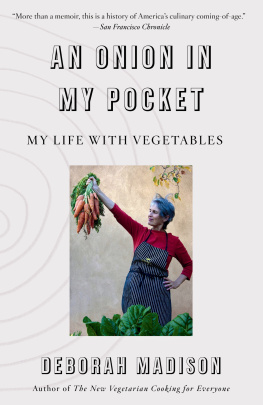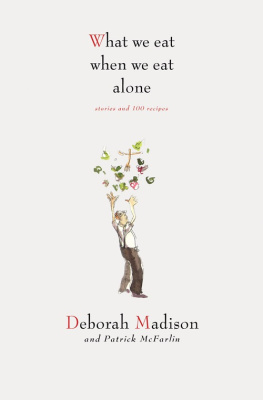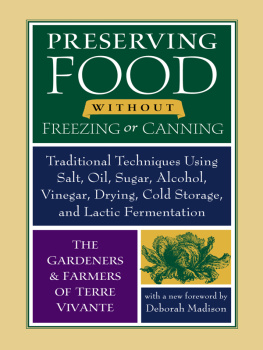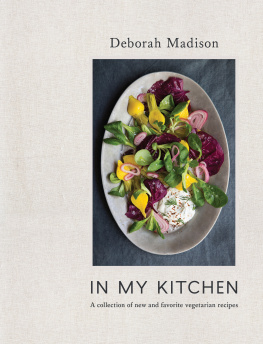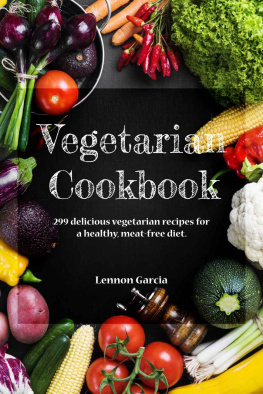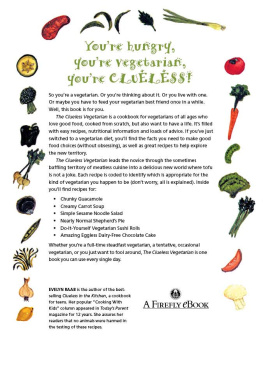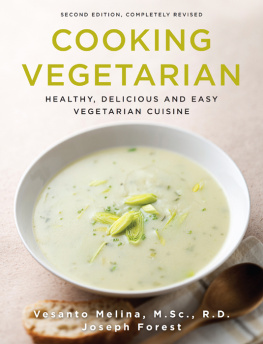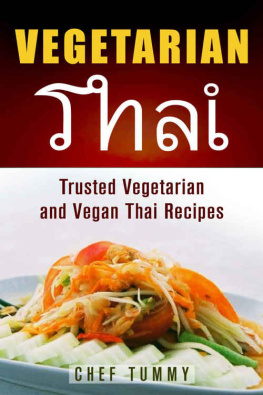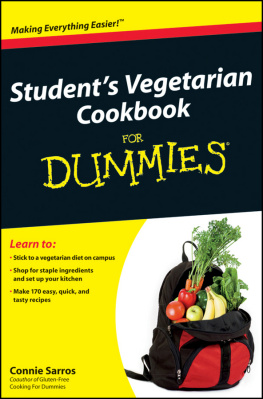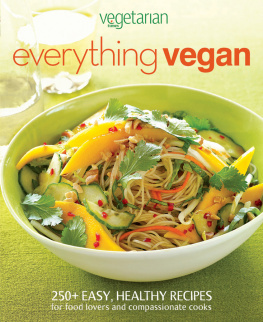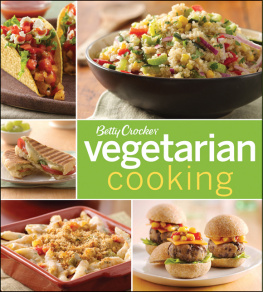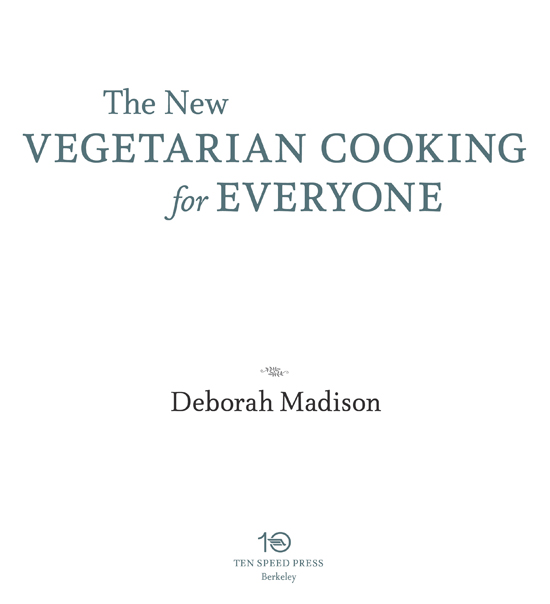Copyright 2014 by Deborah Madison
illustrations copyright 2014 by Yana Beylinson
All rights reserved.
Published in the United States by Ten Speed Press, an imprint of the Crown Publishing Group, a division of Random House LLC, a Penguin Random House Company, New York.
www.crownpublishing.com
www.tenspeed.com
Ten Speed Press and the Ten Speed Press colophon are registered trademarks of Random House LLC
Originally published in hardcover in slightly different form as Vegetarian Cooking for Everyone in 1997, 2007
Library of Congress Cataloging-in-Publication Data
Madison, Deborah.
[Vegetarian cooking for everyone.]
The new vegetarian cooking for everyone / Deborah Madison. First revised edition.
pages cm
Originally published: New York : Broadway Books, 1997.
Includes index.
1. Vegetarian cooking. I. Title.
TX837.M23618 2014
641.5636dc23
2013046540
Hardcover ISBN: 978-1-60774-553-2
eBook ISBN: 978-1-60774-554-9
First Revised Edition
v3.1
This version of Vegetarian Cooking for Everyone is dedicated to all my readers in the past who have cooked from the book, shared it with others, and occasionally sent that note that makes the years spent writing and cooking unquestionably worthwhile.
Contents
Acknowledgments
M Y ORIGINAL ACKNOWLEDGMENTS REMAIN IN MY HEART , for it is still true that my knowledge of food has been shaped by friends, family, and farmers; teachers and students; writers and chefs; and those with whom Ive shared time in the kitchen and at the table, both here and abroad. When it comes to cooking, inspiration and instruction spring from many sources, for food touches all of life. I am forever indebted to many individuals, both intimates and strangers, who have, in their own unique ways, been a part of the creation of this book. In looking back I see that manyeditors, publishers, proofreaders, friends, and cooksare working elsewhere, in other fields, or have even passed from this world. But my gratitude to them remains for their having made Vegetarian Cooking for Everyone a reality. I heartily thank the many readers who have sent me emails and letters over the years, who have spoken to me at events and offered their thoughts and opinions on the book or its recipes. Hearing from you has brought my office and kitchen, sometimes-lonely places, into the world where people cook and eat and share their lives, for which I am ever grateful.
My mother provided me with culinary curiosity in the kitchen, and my father gave me a sense of Midwestern American cooking and the importance of the garden. I am grateful to them both. Others I wish to thank are the farmers in farmers markets everywhere, whose produce and products ensure my love of cooking season after season. I am also especially fortunate to know botanists and plant people who can answer my questions that arise about the plant world. I especially wish to thank all those who have invited me to teach in their schools throughout the years. After all, it was through teaching that Ive been able to meet my readers, and their questions and curiosity inspired me to write this book. To those who have shared their recipes with me, my deep-felt appreciation for your work and generosity.
Ten Speed Press has been the parent to this revised and expanded edition of Vegetarian Cooking for Everyone and it is a lucky book for that reason. Those Ive worked with have been so extraordinarily open and helpful. Thank you Aaron Wehner, Michele Crim, Hannah Rahill, Toni Tajima, Jenny Wapner, and all who have worked on this projectfrom the bottom of my heart. I am especially grateful to Kaitlin Ketchum, who had the most challenging task of wading through countless changes and additions in the making of this new edition, which she did with grace, smarts, and apparent ease.
Doe Coover, who has been my agent for some 20 years now, as always deserves a special hug of gratitude. And finally, its the one who endures projects such as this day after day that deserves special thanks, and that would be my husband, Patrick McFarlin. He has been the patient one, willing to give tempeh a try when hed much rather eat something else, then washing up afterward.
Introduction
P LANT LIFE CAN BE VERY ENTICING . It is visual, tactile, aromatic, and mysterious. Plant foods range from jewel-like beans with their stripes and patterns, to subtle grains, strangely beautiful seaweeds, the aromas of herbs and spices, and of course fruits and vegetables, with their many forms and colors. No less amazing is the ingenuity of man-made foods: coils of pasta, cheeses of all manner, the lustrous hues and fragrances of oils. It was this edible circus that started me cooking, and its still there to suggest a recipe, a meal, a menu, or an excuse for a gathering.
But the idea for Vegetarian Cooking for Everyone came to me after teaching a weeklong cooking class at Esalen Institute in California many years ago. When it ended, I realized that it would be so helpful to have a big book, like the Joy of Cooking , that included all kinds of plant foods between its covers, a real soup-to-nuts kind of book. At that time, vegetarian cooking was something from the fringe, and some foods, like soy milk, for example, were downright obscure and could be purchased only at tiny health food stores. I wondered why some foods had to be hiddencouldnt they be brought forward and included as ingredients, along with other foods, in one place? As it turned out, they could. For some time now, once-obscure foods have filled our supermarkets shelvestheyre even found at gas stations and convenience stores. Today, in terms of food, the world looks very different than it did when I began writing Vegetarian Cooking for Everyone .
More than 17 years have passed since Vegetarian Cooking for Everyone first came out, and those foods that were once scarcely known are now everyday items, and new ones have appeared. In addition, our knowledge about what makes up the foods we eat has deepened, and some foods that were once viewed in such a positive way are now regarded more dubiously. Soy, for example, is not quite the star we once thought it was, and today the emphasis has shifted to fermented soy, not the more common forms, as important.
More people today feel that organically grown foods are better for ones health, and indeed, many foods we never thought would be grown and produced without pesticides, like sugar, are available as organics. Butter isnt always bad. Olive oil is mostly good but still not really regulated; canola oil not so much. Genetically modified organisms (GMOs) are a bigger problem for us today, as they have proliferated and are still unlabeled. We were not eating kale salads at all during the seven years when I was writing Vegetarian Cooking for Everyone ; now theyre everywhere. Coconut oil was still considered a harmful saturated fat. Now its considered a good fat, and a very delicious one, too. Plus we are now cooking with coconut water, curry leaves, and kefir lime leaves. Multiple types of seasoning salts were not on our radar; now theyre part of our pantries. The pressure cooker was more feared then than appreciated; today pressure cookers are safe, popular, and used with ease. Changes in the culture of food have indeed taken place and many new ingredients are ours for the using. In this edition of Vegetarian Cooking for Everyone , you will find nearly all of the recipes you have come to love. But you will also find over 200 new ones and information on new ingredients we have come to know.


